Sure Shot Questions for Board Exams: How do Organisms Reproduce? | Science Class 10 PDF Download
The CBSE Class 10 chapter "How Do Organisms Reproduce?" is pivotal, covering key concepts like plant and human reproduction, asexual reproduction modes, contraception, and genetic variation. By analyzing previous year question papers (2014–2025), we’ve identified recurring question types, topic weightage, and patterns that align with CBSE’s exam framework. Based on these trends and the syllabus’s emphasis, we’ve compiled a list of high-probability questions likely to appear in the upcoming exam. These predictions are rooted in the frequency and style of past questions, ensuring focused preparation.
Here’s a chart showing the frequency of key reproduction-related topics in CBSE Class 10 papers (2014–2025), based on the previous year question analysis:
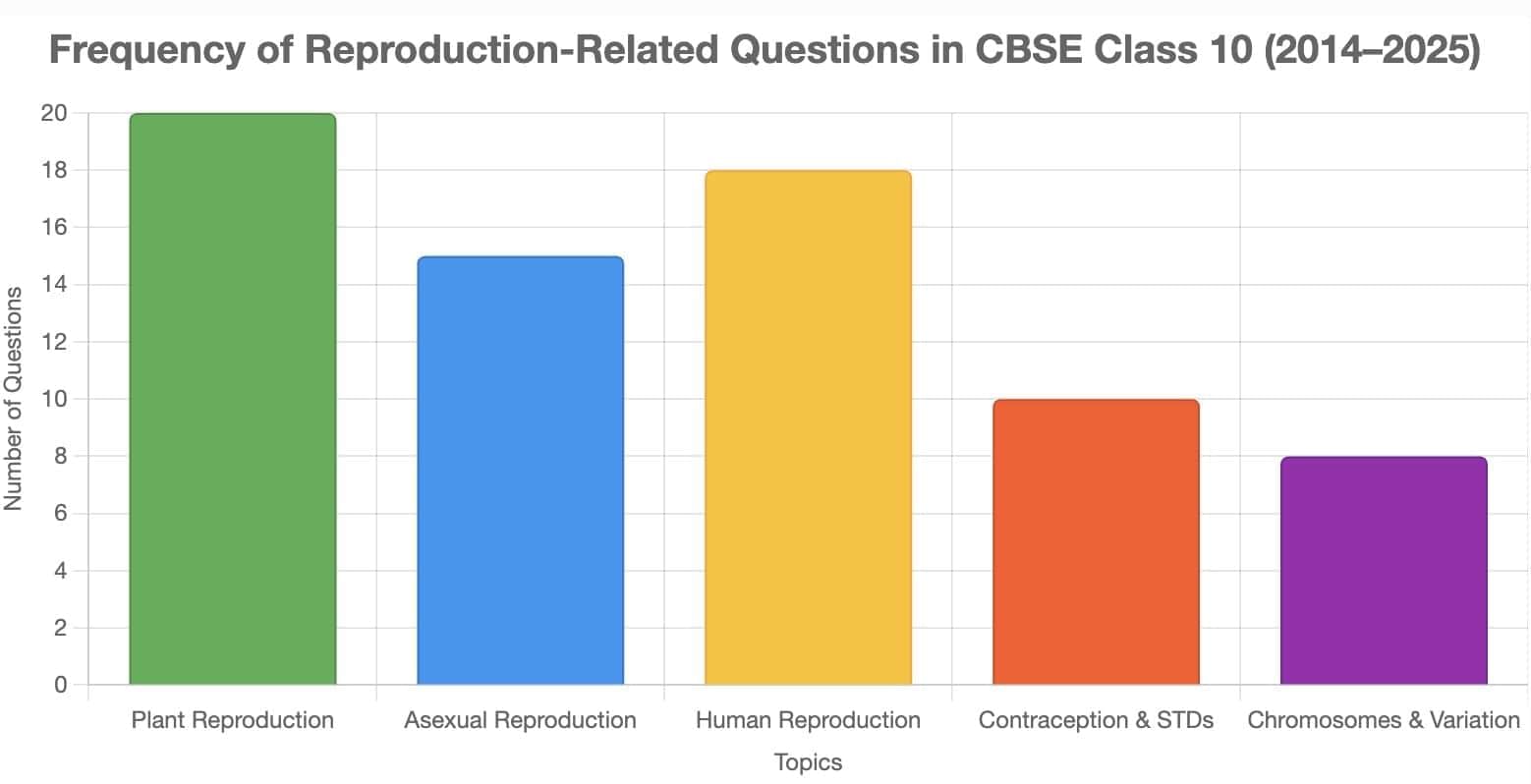
Take a look below for the prioritized questions, supported by examples from past papers to guide your study.
Key Questions
Q1: The plants that can be raised by the method of vegetative propagation are: (1 Mark) (2024)
(a) Sugarcane, roses, grapes
(b) Sugarcane, mustard, potato
(c) Banana, orange, mustard
(d) Papaya, mustard, potato
 View Answer
View Answer 
Ans: (a)
Vegetative propagation is a method of asexual reproduction where new plants are grown from parts of existing plants, such as stems, roots, or leaves. Sugarcane, roses, and grapes can be easily propagated using this method, allowing for the rapid production of new plants with desirable traits.
Q2: A zygote is formed by the fusion of a male gamete and a female gamete. The number of chromosomes in the zygote of a human is: (1 Mark) (2024)
(a) 23
(b) 44
(c) 46
(d) 92
 View Answer
View Answer 
Ans: (c)
In humans, a zygote is formed when a male gamete (sperm) and a female gamete (egg) fuse together. Each gamete contains 23 chromosomes, so when they combine, the zygote has a total of 46 chromosomes, which is the normal number for human cells.
Q3: Identify the mode of asexual reproduction in the following organism: (1 Mark) (2024)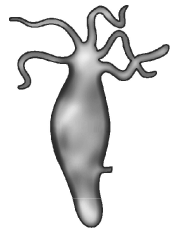 (a) Fragmentation
(a) Fragmentation
(b) Multiple fission
(c) Budding
(d) Binary fission
 View Answer
View Answer 
Ans: (c)
In the organism shown, you can observe a small new organism growing from the body of the larger one. This is typical of budding, where a new organism develops from an outgrowth or bud due to cell division at one particular site. This method is common in yeast and some invertebrates like hydras.
Q4: Assertion (A) and Reason (R), answer these questions selecting the appropriate option given below: (1 Mark) (2024)
Assertion (A): Offsprings produced by asexual reproduction are genetically similar to the parents.
Reason (R): Asexual reproduction involves a single parent.
(a) Both (A) and (R) are true and (R) is the correct explanation of (A).
(b) Both (A) and (R) are true and (R) is not correct explanation of (A).
(c) (A) is true, but (R) is false.
(d) (A) is false, but (R) is true.
 View Answer
View Answer 
Ans: (a)
Offsprings produced by asexual reproduction are genetically identical to their parent because asexual reproduction involves only one parent, resulting in no mixing of genetic material. This is why the assertion about the genetic similarity of offspring and the reason about single-parent involvement are both true and directly related.
Q5: (a) Name the process shown below and define it: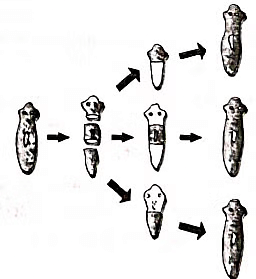 (b) Name the type of cells present in the organisms which exhibit this process. (Term II, 2021)
(b) Name the type of cells present in the organisms which exhibit this process. (Term II, 2021)
 View Answer
View Answer 
Ans: (a) The process shown is regeneration in Planaria. Regeneration is the ability to give rise to a new individual from any broken or injured body part.
(b) Regeneration in Planaria is carried out by specialised cells known as neoblasts (stem cells).
Q6: (a) What provides nutrition to human sperms? State the genetic constitution of a sperm.
(b) Mention the chromosome pair present in a zygote which determines the sex of (i) a female child and (ii) a male child. (2020)
 View Answer
View Answer 
Ans: (a) The secretions of seminal vesicles and prostate gland provides nutrition to the human sperms and also make their further transport easier. The genetic constitution of a 50% sperm have X chromosome and 50% have Y chromosome.
(b) (i) X X - Female child
(ii) X Y - Male child
Q7: (A) Name the parts of a bisexual flower that are not directly involved in reproduction.
(B) Differentiate between self-pollination and cross-pollination. List any two significance of pollination.
(C) What is the fate of ovules and ovary after fertilisation in a flower? (4 to 5 Marks) (CBSE 2023)
 View Answer
View Answer 
Ans: (A) The sepals and petals of a flower are non-essential parts. They specialise in protecting the reproductive organs and draw pollinators like insects and birds. The gynoecium and androecium are the flower's essential parts that are directly involved in reproduction.
(B)
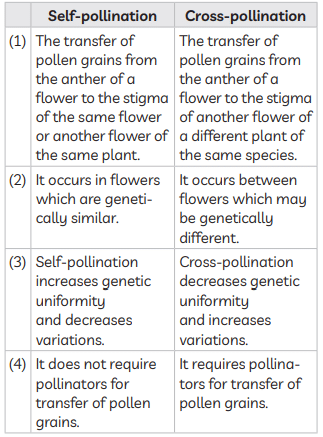
Significance:
(i) Plant reproduction and genetic diversity.
(ii) Food production.
(C) The ovules develop into the seed and the ovary develops into the fruit after the fertilisation in a flower.
Q8: Case-based/data-based questions with 3 short sub-parts. Internal choice is provided in one of these sub-parts. (4 to 5 Marks)(2024)
Pollination is an important process in sexual reproduction of plants. It is an essential process that facilitates fertilisation in plants. Pollinating agents can be wind, water, insects and birds. Several changes take place in the flower after the fertilization has taken place.
(a) Write the main difference between self-pollination and cross-pollination.
(b) Name the part of the flower which attracts insects for pollination. What happens to this part after fertilisation?
(c) (i) Define fertilisation. What is the fate of ovules and the ovary in a flower after fertilisation?
OR
(c) (ii) In a germinating seed, which parts are known as future shoot and future root? Mention the function of cotyledon.
 View Answer
View Answer 
Ans: (a) (b) Petals, they dry and fall off.
(b) Petals, they dry and fall off.
(c) (i) Fusion of male and female gametes to form a zygote
Ovule - Seed,
Ovary - fruit
OR
(c) (ii) Future shoot - Plumule,
Future root - Radicle
Cotyledon - Stores food.
Q9: (a) (i) What are spores? On which structures are they formed? How do they overcome unfavourable conditions? Name the organism which multiplies with the help of these structures. (4 to 5 Marks) (2024)
(ii) Give two reasons why some plants are grown by the method of vegetative propagation. List two methods used to grow plants vegetatively.
OR
(b) (i) Study the diagram given below and name the parts marked as A, B and C. What happens when B reaches C in the ovary ? Mention its significance.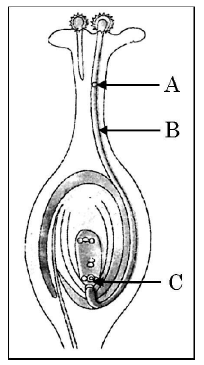 (ii) Write the post fertilisation changes that occur in a flower.
(ii) Write the post fertilisation changes that occur in a flower.
 View Answer
View Answer 
Ans: (a) (i)
- Spores are reproductive structures that detach from the parent and give rise to a new individual.
- Sporangium / Sporangia
- Covered by thick walls to protect them from unfavourable conditions.
- Rhizopus
(ii)
- Plants which have lost the capacity to produce seeds.
- Plants bear flowers and fruits earlier so as to reduce time.
- To get genetically similar plants.
Methods: Layering and Grafting
OR
(b) (i)
- A - Male Germ Cell/Male Gamete; B - Pollen tube; C - Female Germ Cell / Female Gamete.
- B carries A (male germ cell) and this germ cell fuses with C (female germ cell) to form a zygote.
- Significance: Zygote is capable of growing into a new plant.
Q10: What Is puberty? Mention any two changes that are common to both boys and girls in early teenage years (2022)
 View Answer
View Answer 
Ans: Puberty is the age of human males and females at which the reproductive organs become functional, gonads start producing gametes and sex hormones, and the boys and the girls become sexually mature. Changes that are common to both boys and girls in early teenage years are as follows :
- Hair grows in the pubic area and armpits
- Increase in height and acquisition of muscle mass.
Q11: Name the part/organ of the human female reproductive system (2022)
(a) where contraceptive devices such as loop or copper-T are placed to prevent pregnancy.
(b) which is blocked to prevent the transfer of eggs.
(c) where formation of green cells as ova takes place.
(d) from where the embryo gets nutrition from the mother’s blood.
 View Answer
View Answer 
Ans: (a) The part/organ of the human female reproductive system where contraceptive devices such as loop or copper-T are placed to prevent pregnancy is the uterus or womb. These devices are inserted into the uterus to inhibit fertilization and implantation of a fertilized egg.
(b) The part/organ of the human female reproductive system that is blocked to prevent the transfer of eggs is the fallopian tubes. These tubes connect the ovaries to the uterus, and they are blocked or sealed off in certain contraceptive methods or sterilization procedures to prevent the eggs from reaching the uterus for fertilization.
(c) The part/organ of the human female reproductive system where the formation of green cells as ova takes place is the ovaries. Ovaries are responsible for producing and releasing mature eggs, or ova, during the menstrual cycle.
(d) The part/organ of the human female reproductive system from where the embryo gets nutrition from the mother's blood is the placenta. The placenta is a temporary organ that develops during pregnancy and attaches to the uterine wall. It facilitates the exchange of nutrients, oxygen, and waste products between the mother's blood and the developing fetus.
Q12: (i) Draw a diagram showing spore formation in Rhizopus and label the (a) reproductive and (b) non-reproductive parts. Why does Rhizopus not multiply on a dry slice of bread?
(ii) Name and explain the process by which reproduction takes place in Hydra.
 View Answer
View Answer 
Ans: (i)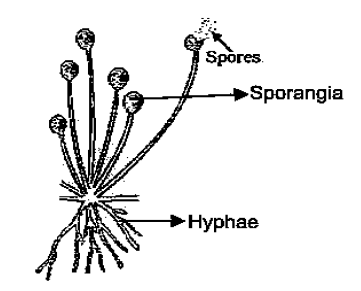
(a) Reproductive part – Sporangia
(b) Non-reproductive part – Hypha/Hyphae.
Dry slice of bread does not provide moisture and nutrients necessary for the germination and multiplication of Rhizopus.
(ii) Budding: Hydra uses regenerative cells for reproduction. A bud develops as an outgrowth due to repeated cell division at one specific site and develop into tiny individuals. On maturation, these buds detach from the parent and become new individuals.
Alternate answer: Regeneration: It is carried out by specialised cells. If hydra is cut or broken into many pieces, many of these pieces grow into separate individuals.
Q13: Draw a neat diagram showing fertilisation in a flower and label
(a) pollen tube
(b) Male germ cell and
(c) Female germ cell on it.
Explain the process of fertilisation in a flower.
What happens to the (i) ovary and (ii) ovule after fertilisation? (2020)
 View Answer
View Answer 
Ans: Diagram showing fertilisation in a flower is as follows: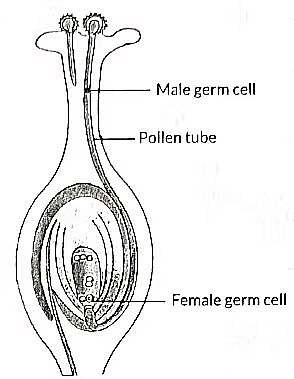 Fertilisation, in plants, occurs when the male gamete present in pollen grain fuses with the female gamete (or egg) present in ovule. When a pollen grain falls on the stigma of the carpel, it bursts open and grows a pollen tube downwards through the style towards the female gamete in the ovary. Male gametes move down the pollen tube. The pollen tube enters the ovule in the ovary. The tip of pollen tube bursts and male gametes comes out of pollen tube. In ovary, the male gamete of pollen combines with the female gamete or egg present in ovule to form a fertilised egg. After fertilisation,(i) ovule develops into seed
Fertilisation, in plants, occurs when the male gamete present in pollen grain fuses with the female gamete (or egg) present in ovule. When a pollen grain falls on the stigma of the carpel, it bursts open and grows a pollen tube downwards through the style towards the female gamete in the ovary. Male gametes move down the pollen tube. The pollen tube enters the ovule in the ovary. The tip of pollen tube bursts and male gametes comes out of pollen tube. In ovary, the male gamete of pollen combines with the female gamete or egg present in ovule to form a fertilised egg. After fertilisation,(i) ovule develops into seed
(ii) ovary develops into fruit.
Q14: Explain the events that take place once a sperm reaches the oviduct till it becomes a foetus. Write the role of the placenta in pregnancy. (3 Marks) (2024)
 View Answer
View Answer 
Ans:
- In the oviduct, sperm encounters the egg and fertilisation takes place.
- The fertilized egg (zygote) starts dividing and forms a ball of cells or embryo.
- Embryo is implanted in the lining of the uterus, where it continues to grow and develops organs to become a foetus.
- Role of Placenta:
(i) Provides a large surface area for glucose and oxygen to pass from the mother to the embryo.
(ii) Waste generated by the embryo will be removed by transferring them into the mother’s blood.
Q15: List two roles of each of the following in human reproductive system :
(i) Seminal vesicles and prostate gland
(ii) Oviduct
(iii) Testis
 View Answer
View Answer 
Ans: (i) Seminal vesicles and prostate glands:
- Secrete a fluid for nourishment of sperms.
- Secrete a fluid which makes the transport of the sperms easier
(ii) Oviduct:
- Egg is carried from ovary to the womb or uterus.
- Site of Fertilization
(iii) Testis:
- Produces sperms
- Secretion of hormone – testosterone
Q16: The incorrect statement about placenta is: (1 Mark) (2024)
(a) It is a disc embedded in the uterine wall.
(b) It contains villi on the embryo’s side of the tissue.
(c) It has a very small surface area for glucose and oxygen to pass from mother to the embryo.
(d) The embryo gets nutrition from the mother’s blood through it.
 View Answer
View Answer 
Ans: (c)
This statement is incorrect because the placenta actually has a large surface area, which allows for efficient transfer of nutrients like glucose and oxygen from the mother's blood to the embryo. The placenta is designed to maximize the exchange of these essential substances to support the developing fetus.
Q17: (a) Draw a diagram of human female reproductive system and label the parts:
(i) which produce an egg
(ii) where fertilisation takes place
(b) List two bacterial diseases which are transmitted sexually.
(c) What are contraceptive devices? Give two reasons for adopting contraceptive devices in humans. (Al 2019)
 View Answer
View Answer 
Ans: (a) The sectional view of human female reproductive system is as follows: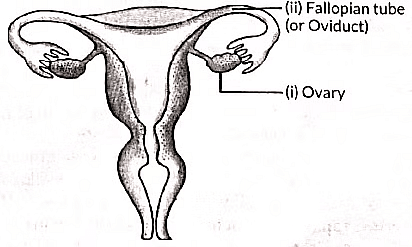 (b) Gonorrhoea and syphilis are two bacterial diseases which are transmitted sexually.
(b) Gonorrhoea and syphilis are two bacterial diseases which are transmitted sexually.
(c) Contraceptive devices are those devices which are used to prevent pregnancy. It includes diaphragm, condom and intrauterine devices. Contraceptive methods are adopted:
(i) to avoid unwanted birth.
(ii) to keep the population of a country under control.
Q18: (a) Identify the given diagram. Name the parts 1 to 5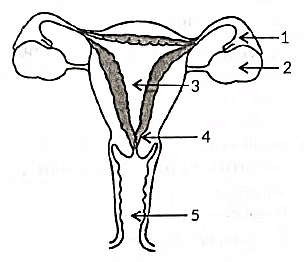 (b) What is contraception? List three advantages of adopting contraceptive measures. (NCERT Exemplar, Delhi 2019)
(b) What is contraception? List three advantages of adopting contraceptive measures. (NCERT Exemplar, Delhi 2019)
 View Answer
View Answer 
Ans: (a) The given diagram is the sectional view of human female reproductive system. The labelled parts are:
1. Funnel of fallopian tube or oviduct
2. Ovary
3. Uterus or womb
4. Cervix
5. Vagina
(b) Contraception is the avoidance of pregnancy. Three advantages of adopting contraceptive methods are:
(i) They prevent frequent or unwanted pregnancies.
(ii) They prevent the transfer of sexually transmitted infections.
(iii) They help to regulate the population growth.
Important Topics for Preparation
A. Plant Reproduction
1. Self-Pollination vs. Cross-Pollination:
- Self-pollination involves pollen transfer within the same flower/plant (e.g., mustard, hibiscus), leading to genetic uniformity.
- Cross-pollination involves pollen transfer between different plants, promoting genetic diversity and better survival. Understand why cross-pollination enhances adaptability.
Focus: Differences, advantages, and examples of bisexual/unisexual flowers.
2. Fertilization in Flowers:
- Pollen lands on stigma (pollination), germinates, forms a pollen tube, and delivers male gametes to the ovule in the ovary for fertilization, forming a zygote.
- Diagrams require labeling stigma, anther, pollen tube, ovule.
Focus: Process description, diagram labeling, and role of pollination.
3. Post-Fertilization Changes:
- Ovule → seed (embryo + seed coat), ovary → fruit, petals/stamens/stigma/style wither.
- The zygote develops into an embryo.
Focus: Changes in flower parts and their significance.
4. Parts of a Bisexual Flower:
- Reproductive parts: stamen (anther: produces pollen; filament: supports anther), carpel (stigma: receives pollen; style: supports pollen tube; ovary: contains ovules).
- Non-reproductive: petals (attract pollinators), sepals (protect bud).
Focus: Functions and identification in diagrams.
B. Asexual Reproduction
1. Modes of Asexual Reproduction:
Key Points:
- Binary Fission: Cell splits into two (e.g., Amoeba: irregular plane; Leishmania: longitudinal plane).
- Budding: Outgrowth forms new individual (e.g., Hydra).
- Fragmentation: Organism breaks into fragments, each growing into a new individual (e.g., Spirogyra).
- Regeneration: Regrowth from cut parts (e.g., Planaria).
- Spore Formation: Spores in sporangia develop into new individuals (e.g., Rhizopus).
Focus: Definitions, examples, and processes.
2. Vegetative Propagation:
- Asexual reproduction using plant parts (e.g., Bryophyllum: leaf buds, rose: stem cuttings, banana: suckers).
- Advantages: faster growth, seedless plant propagation, preserves desirable traits.
Focus: Methods (cutting, layering, grafting), examples, and advantages.
3. Advantages of Asexual Reproduction:
- Faster, single parent, genetically identical offspring (clones) preserve successful traits.
- Assertion-reason questions link genetic similarity to single-parent reproduction.
Focus: Comparison with sexual reproduction, genetic uniformity.
C. Human Reproduction
1. Functions of Reproductive Organs:
- Female: Ovary (produces eggs, hormones: estrogen/progesterone), fallopian tube (fertilization site), uterus (implantation, embryo growth), vagina (sperm entry).
- Male: Testes (produce sperm, testosterone), seminal vesicles/prostate (secrete fluid for sperm nourishment/transport), vas deferens (transports sperm), scrotum (maintains lower temperature for spermatogenesis).
Focus: Roles and diagram labeling.
2. Fertilization and Post-Fertilization Changes:
- Fertilization in fallopian tube forms a zygote, which implants in the uterus.
- Endometrium thickens post-fertilization; placenta forms for nutrient/oxygen exchange.
- If unfertilized, endometrium sheds (menstruation).
Focus: Process, placenta role, and uterine changes.
Sex Determination:
- Father (XY) contributes X or Y sperm; mother (XX) contributes X. XX = female, XY = male.
- Flowcharts show gamete contribution and zygote formation.
Focus: Mechanism, flowchart, and chromosome pairs.
D. Contraception and Sexually Transmitted Diseases (STDs)
1. Contraceptive Methods:
- Barrier: Condoms (prevent sperm entry, irritation as side effect).
- Chemical: Oral pills (alter hormonal balance, cause imbalance).
- Intrauterine Devices (IUDs): Copper-T (uterine irritation, female-only).
- Surgical: Vasectomy/tubectomy (block gamete transport, risk of infection).
Focus: Types, side effects, and gender-specific methods.
2. Sexually Transmitted Diseases:
- Bacterial (gonorrhea, syphilis), viral (HIV/AIDS, genital herpes).
- Prevention: condoms, safe practices.
Focus: Examples and prevention methods.
E. Chromosomes and Variation
1. Chromosome Number Maintenance:
- Meiosis halves chromosome number in gametes (23 in humans).
- Fertilization restores diploid number (46) in zygote. Example: Human sperm (23) + egg (23) = zygote (46).
Focus: Meiosis, fertilization, and chromosome counts.
2. Variation and Its Role:
- Variation from DNA copying errors and sexual reproduction (gamete fusion) enhances adaptability, promoting species survival in changing environments.
- Focus: Sources of variation and survival benefits.
Preparation Tips
- Prioritize: Plant reproduction (pollination, fertilization), human reproduction (organs, sex determination), and asexual reproduction modes due to high frequency.
- Practice: Diagrams (flower, human reproductive system), flowcharts (sex determination), and Punnett squares (Mendel’s crosses).
- Memorize: Definitions (e.g., pollination, regeneration), examples (e.g., Spirogyra: fragmentation), and key terms (e.g., zygote, placenta).
- Use NCERT: Focus on examples and processes from the textbook for clarity.
- Solve Past Papers: Target recurring questions (e.g., Q2-2025, Q12-2024) to understand CBSE’s framing style.
|
80 videos|569 docs|80 tests
|
FAQs on Sure Shot Questions for Board Exams: How do Organisms Reproduce? - Science Class 10
| 1. What are the main types of reproduction in organisms? |  |
| 2. How do organisms ensure genetic diversity through reproduction? |  |
| 3. What are the advantages and disadvantages of asexual reproduction? |  |
| 4. What role do environmental factors play in the type of reproduction an organism may choose? |  |
| 5. Can you explain the process of fertilization in sexual reproduction? |  |





















